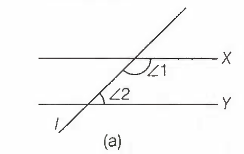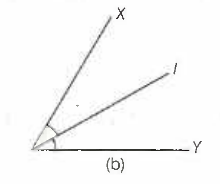 Multiple Choice Questions
Multiple Choice QuestionsIn a pair of adjacent angles (i) Vertex is always common, (ii) one arm is always common and (iii) uncommon arms are always opposite rays. Then
(ii) is false
(iii) is false
All (i), (ii) and (iii) are true
(i) is false, but (ii) and (iii) are true
D.
(i) is false, but (ii) and (iii) are true
(i) Vertex is always common. (false)
It is not necessary that vertex is always common as in case of parallel lines, vertex is not common of lines which forms pair of adjacent angles are adjacent angles. But vertex is not common.

(ii) One arm is always common. (True)
In both figures (a) and (b), l is the common arm

(iii) Uncommon arms are always opposite rays (True)
In both figure, X and Y are uncommon arms. And, they are always opposite ray
The angles of a quadrilateral are in the ratio 2 : 3 : 5 : 8. The sum of the supplement of the largest angle and the complement of the smallest angle is
500
800
600
700
If one angle ofa triangle is 110°, then the angle between the bisectors of the other two angles measures
900
1450
1000
1100
The students (in Lakh) who appeared and ratio of pass and fail in different cities are given in the following table. Read carefully and answer following question
| City | Applicants (in lakh) | Ratio of Pass and Fail |
| A | 1.25 | 7 : 3 |
| B | 3.14 | 5 : 3 |
| C | 1.08 | 4 : 5 |
| D | 2.27 | 1 : 3 |
| E | 1.85 | 3 : 2 |
| F | 2.73 | 7 : 5 |
How many applicants pass in City E ?
13000
1110000
113000
111000
